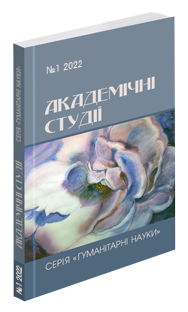Abstract
The article considers the image (branding ) strategy, which is implemented in advertising discourse, where attention is focused on the influential characteristics of this strategy. The peculiarities of the image, the specifics of its actualization in advertising discourses, the properties that allow to differentiate goods or services among identical ones. Particular attention is paid to the techniques that most often shape the strategy of the brand image or company image: accentuation, hyperbole, contamination, where the latest is leading in advertising. The article considers such an image strategy, which is implemented in advertising discourse, where attention is focused on the influential characteristics of this strategy. The peculiarities and properties of the image, the specifics of its actualization in advertising discourses are detailed, the stereotypes and emotionality of the actual advertising image are emphasized. The outlined image characteristics make it’s possible to differentiate goods or services among identical to attract the attention of consumers. The specificity of the general principle of image strategy in advertising discourse is emphasized to find the most successful image for each product or companyand to form through advertising, and further enshrined in the minds and subconscious of consumers, where this image (image) becomes the object of desires. Emphasis is placed on the special status of associative perceptual opportunities of advertising image that arise in recipients in contact with the product or company, and further acquires signs of symbolism, the image creates strong associative ties with the product, which marks a certain lifestyle and behavior, environment, circle communication, etc. The image characteristics of the product can create a marker of masculinity or femininity, youth or old-fashionedness, etc. In this way, the projection of the image of the product is synthesized with its real original, which is beyond doubt about its consumer characteristics and becomes an object of faith (trust), encouraging the appropriate behavior of potential consumers. Particular attention is paid to the techniques that most often shape the strategy of the brand image or company image: emphasis, hyperbole, contamination. Contamination is considered to be the leading one in advertising, which adds imaginary values to the image of advertised goods or services, turning them into certain symbols, often of a status nature.
References
Іванченко Р. Г. Словник термінів. Київ : Патент, 1998. 208 с.
Ильинский С. В. Общественные связи. Реклама. Маркетинг. Нейролингвистическое программирование. Оперативный словарь-справочник. Москва : АСТ ; Восток – Запад, 2006. 479 с.
Кармин А. С. Психология рекламы. СПб. : Питер, 2004. 512 с.
Ковалевська Т. Ю. Психолінгвістичні активатори сприйняття рекламних комплексів. Одеська лінгвістична школа: кола реконструкцій : колективна монографія. Одеса : ПолиПринт, 2020. С. 303‒312.
Кутуза Н. В. Комунікативна сугестія в рекламному дискурсі: психолінгвістичний аспект : монографія. Київ : Видавничий дім Дмитра Бураго, 2018. 736 с.
Медведева Е. В. Рекламная коммуникация. Москва : Едиториал УРСС, 2004. 280 с.
Назайкин А. Рекламный текст в современных СМИ : практическое пособие. Москва : ЭКСМО, 2007. 352 с.
Песоцкий Е. Современная реклама. Теория и практика. Ростов н/Д : Изд-во «Феникс», 2003. 352 с.
Ромат Є. В. Словник основних рекламних і маркетингових термінів. Харків : Студцентр, 2003. 56 с.
Смирнова Т. В. Моделювання рекламного іміджу: навчальний посібник. Київ : Інститут журналістики, 2004. 166 с.

